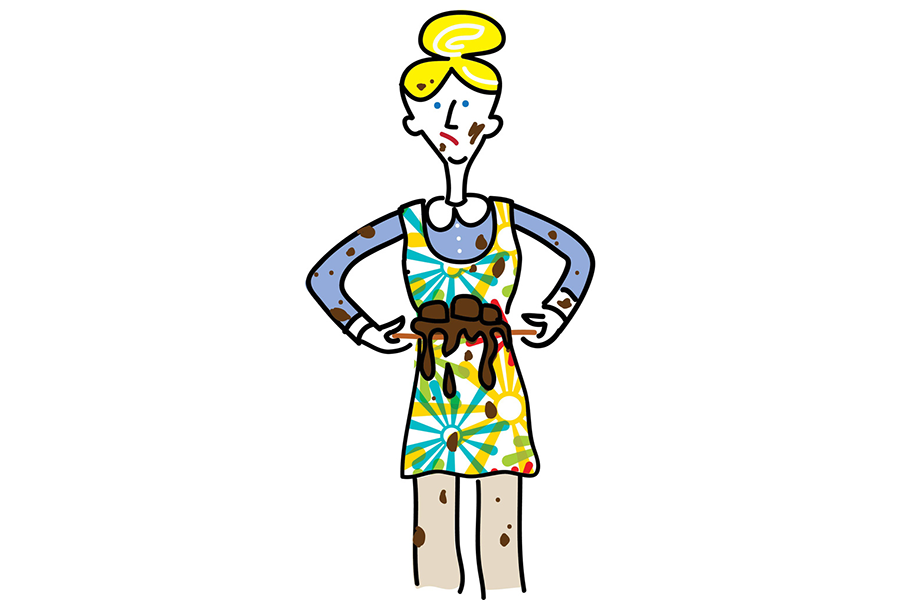How Mom made fudge by feel
Loading...
My mother was an excellent cook. Her fried chicken was crispy perfection, and her corn pudding was fluffy and light. But she had blind spots, and one of them was fudge.
In my house, we all knew how real fudge was made – and it wasn’t with marshmallow cream.
You started with sugar and cocoa in a saucepan. You stirred in milk, brought it to a boil, then let it simmer until ... well, this was the tricky part. You never really knew how long to let it simmer. Until it was done, of course, but doneness was subjective.
You tested for doneness by spooning a drop of the mixture into a cup of cold water. If it congealed into a ball firm to the touch, you could take the pan off the stove and add butter and vanilla. When it had cooled a bit (again, subjective), you started beating it vigorously with a wooden spoon. And just when it started looking dull rather than glossy (again, subjective), you poured it into a well-buttered pan.
Ideally, the fudge would harden after being cooled, beaten, and poured into a buttered pan. But this was never a guarantee. In fact, more times than not it would harden as you were pouring, a corrugated waterfall of chocolate. Or it might harden in the pan in such a determined fashion that it could be removed only by diligent chiseling.
Other times, you’d find yourself with the opposite problem: The mixture would appear to be done, so you’d take it off the stove and beat it till your arm ached, to no avail. That evening you’d spoon fudge sauce over your ice cream.
The problem lay in doneness detection. Just how congealed should the fudgy ball be? If there was a hungry crew waiting, it was easy to imagine the ball was more solid than it actually was.
A hopeless situation? It shouldn’t have been. We could have noted the simmer time of each batch of fudge we made. We could have consulted a recipe, though this may have led us to the dreaded marshmallow cream version.
Or we could have bought a candy thermometer to measure the temperature of the liquid and know exactly when to take it off the stove and just when to start stirring. Except we would never do this, because this was cheating.
I can still remember Mom laughing after each batch of failed fudge. “What I really need is a candy thermometer,” she’d say. But she never used one.
We all know experienced cooks who pride themselves on knowing how thick to roll the biscuit dough or how long to stir the gravy. But their results are usually consistent. Mom’s fudge, on the other hand, could be a creamy smooth, melt-in-your-mouth delight; a grainy, dry, stuck-in-the-pan disaster; or fudge sauce for ice cream. And you could never predict which it would be. The most promising batch might never set. The most frustrating one could pull through. Was it the humidity? The distractibility of the cook?
Some of the best fudge I’ve made was fudge I almost forgot. A watched pot never congeals, perhaps. But deliberately ignoring the fudge doesn’t work. You must honestly ignore it.
What you must never do, of course, is use a candy thermometer. I don’t, and neither do my daughters. I’ve raised a trio of fudge scofflaws, renegades who think they can outwit the forces of nature and chemistry. Do they? You bet ... sometimes. As for the rest? Grab your spoon.
Old-fashioned chocolate fudge
Makes 36 pieces (or one big glop, depending)
3 cups sugar
3/4 cup cocoa powder
1-1/2 cups whole milk
1/2 cup butter (one stick)
1 teaspoon vanilla
PREPARATION: Grease well an 8- or 9-inch pan and set aside. In a medium, heavy-bottomed saucepan, stir together sugar, cocoa powder, and milk. Bring mixture to a boil. Reduce heat and simmer, uncovered, for 20 to 25 minutes, until a drop of the mixture congeals into a soft, somewhat flattened ball when dropped in a cup of cold water. (If you must use a candy thermometer, it should read 235 degrees F.)
Remove from heat. Add butter and vanilla, but do not stir! Let cool (to 130 degrees F. or still warm to the touch). Beat vigorously with a wooden spoon until it thickens and the color changes from glossy to dull. This is crucial to the fudge’s texture. It’s a subtle change that can take 15 to 20 minutes to occur. When it happens, pour quickly into the greased pan.
This is when you start hoping that it hardens. Let it cool in a dry place for at least an hour, until firm. (But if not, try it on ice cream!)







